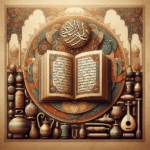The Impact of the Arabic Alphabet on Literary Works 📚
Welcome to a deep dive into the fascinating world of the Arabic alphabet and its profound influence on literature. Whether you’re a language enthusiast, a literature lover, or simply curious about cultural history, this exploration promises to be both enlightening and engaging. So, let’s embark on this linguistic journey together!
Table of Contents
1. Introduction to the Arabic Alphabet
2. Historical Significance and Evolution
3. Influence on Classical Arabic Literature
4. The Arabic Alphabet and Modern Literature
5. Conclusion: The Timeless Legacy
6. FAQs
Introduction to the Arabic Alphabet
The Arabic alphabet is more than just a series of characters; it’s a gateway to a rich tapestry of history, culture, and artistic expression. Comprised of 28 letters, the script is used predominantly in the Arabic language, and its elegant curves and dots are not only aesthetically pleasing but also serve as a bridge across time and space, connecting generations of writers and readers.
Historical Significance and Evolution 🕰️
Originating over a thousand years ago, the Arabic alphabet has undergone significant evolution. Initially derived from the Nabataean script, it became the lingua franca of the Islamic Golden Age, a period marked by remarkable advancements in science, philosophy, and the arts. This historical context laid the groundwork for the alphabet’s enduring impact on literary traditions.
Influence on Classical Arabic Literature 📖
In classical Arabic literature, the alphabet served as the medium through which poets and scholars expressed their thoughts and emotions. Works like the „Qur’an“ and the poetry of Al-Mutanabbi showcase the script’s capacity for conveying complex ideas and intricate emotions. The rhythm and beauty of the script itself often mirror the literary content, adding an extra layer of depth and resonance.
The Arabic Alphabet and Modern Literature ✨
Fast forward to today, and the Arabic alphabet continues to inspire contemporary writers. Its adaptability allows for the expression of modern themes and narratives while maintaining a connection to the past. Authors like Naguib Mahfouz have harnessed the power of the script to craft stories that resonate globally, proving that the alphabet’s influence is as potent as ever.
Conclusion: The Timeless Legacy 🌟
The Arabic alphabet stands as a testament to the enduring power of language and its ability to shape and reflect human experience. Its impact on literary works has transcended centuries, leaving an indelible mark on both Eastern and Western literary traditions. As we continue to explore and embrace this script, we honor its legacy and ensure its place in the annals of world literature.
FAQs
Q1: How did the Arabic alphabet originate?
A1: The Arabic alphabet originated from the Nabataean script and evolved over time, becoming a crucial part of the Islamic Golden Age.
Q2: What are some notable literary works that use the Arabic alphabet?
A2: Notable works include the „Qur’an,“ the poetry of Al-Mutanabbi, and modern novels by authors like Naguib Mahfouz.
Q3: How does the Arabic alphabet affect modern Arabic literature?
A3: The alphabet continues to inspire contemporary writers, allowing them to express modern themes while maintaining a connection to historical and cultural roots.
Thank you for joining me on this exploration of the Arabic alphabet’s literary impact. Feel free to leave your thoughts and questions in the comments below! 😊





